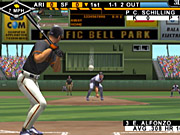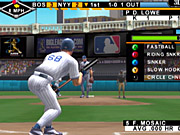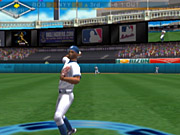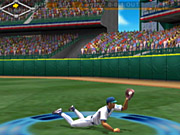In the past, the only way you could play 3DO's popular High Heat Major League Baseball series was to do so on a personal computer or a Sony video game console. This year's installment, High Heat Major League Baseball 2004, is available for all three major consoles. It may not offer as many features or have the same level of graphical pop as the other baseball games on the shelf, but you'd be hard-pressed to come away dissatisfied.

Right off the bat, the Xbox version of High Heat 2004 has a leg up on its PlayStation 2 and GameCube counterparts because it includes the ability to download mid-season roster updates using Microsoft's Xbox Live service. Since baseball games are shipped before the season begins, the rosters are always stale by the time April comes around. High Heat also has an edit mode that allows you to modify existing players and create custom players of your own, but it's much easier to just go online and download the current league. For people who want up-to-date rosters, this is a priceless option.
The play options are about what you'd expect from a game that's billed as an authentic baseball simulation. Standard options include exhibition, season, all-star game, playoffs, batting practice, and home run derby. There are also two career modes, both of which allow you to create a team from the draft level and take it through multiple seasons. Unique to the High Heat series is the two-on-two showdown mode, in which you select a pitcher and hitter from one team and have them participate in a scoring contest against a pair of players from another team. There aren't any other players on the field. You earn points by throwing strikes and getting base hits. Each team gets three outs apiece, and the scoring is usually pretty outrageous, which makes it a perfect mode to play with human opponents.
The franchise mode includes most of the necessary options. You can't create expansion teams, hire coaches, or select alternative stadiums like you can in Acclaim's or Sega's baseball games, but High Heat 2004 emphasizes player management, placing the focus on tracking team finances and managing your roster. You can sign free agents and make trades, and there are three levels of minor league teams available, so you're free to promote rookies and send slumping or injured players down for rehabilitation. At the same time, the players you sign in the off-season or acquire in trades count against your overall budget. Like a real general manager, your job is to put together the best team in your price range so you can eventually reach the playoffs.
One of the game's better features is its tuning menu, which lets you adjust 20 different gameplay settings, such as runner speed, human batting averages, contact power, and the frequency of foul and fly balls. You can even tweak the speed settings for every specific pitch in the game. Each aspect has a slider that lets you choose exactly how difficult or realistic it should be. In this manner, you can customize the game to suit your tastes and skill level.

The most impressive aspect of High Heat Major League Baseball 2004 is that it re-creates the on-field experience of baseball perfectly. Everything you could possibly see in a real baseball game is here. This includes the basics, such as relay throws, CPU walks, and pitcher warm-ups, as well as a plethora of uncommon situations such as dropped third strikes, passed balls, and appeals to the baseline umpires. The level of intelligence shown by the computer is remarkable. It will play lefty vs. righty matchups and give intentional walks to players who are on a hot streak. If you're leading the CPU by a bunch of runs late in a game, it will replace its star players to rest them for tomorrow's game--just like a real MLB manager would.
Even though it has all the traits of a simulation, High Heat 2004 isn't complicated to play. When you're up to bat, there aren't any batting cursors or power meters to deal with. Instead, the timing of your swing is the primary factor that influences your ability to make contact. To improve your odds, you also have the option of trying to guess which pitch the pitcher will throw. Predict it correctly and you're more likely to eek out a hit. As you swing, you can push or pull the ball by angling the control stick. This lets you aim for holes in the infield or reach for a surprise hit. Pitching is much the same. You have your choice of pitches and can select the general placement of the pitch in the strike zone, but it's your pitcher's real-life mastery over specific pitches that dictates whether you'll throw accurately. Each player has between four and six pitches in his repertoire, and there are more than 30 different pitch types available overall. Every so often, a player in the field will catch a line drive or a ground ball before the graphics actually show him doing so, but this is about the only flaw even worth mentioning. Overall, the gameplay is right on target.
For the most part, the graphics do a good job of depicting the action on the field and presenting a realistic stadium environment. The stadium dimensions are reasonably accurate and contain many of the landmarks you'd see at an actual game. Cubs fans, for example, can zoom in on the outfield using the instant replay camera and observe the spectators on top of the sports bars across the street from Wrigley Field. Inside the stadium, jumbo video screens display a live view of the hitter at the plate. Little touches, such as flapping flags and spectators on the bullpen runways, are also included. On the field, the players show off a wide range of motion. Plays such as leaning grabs, relay throws, and spinning double plays all have specific animations devoted to them.

Overall, the game has a clean, sharp look. The players look vibrant in their uniforms, and you can easily make out all the lettering on the signs in the outfield. Even so, High Heat Major League Baseball 2004 looks plain compared with the other baseball games that are currently available. It's great that the players' bodies are so large and that they have such a wide range of motion, but their faces look nothing like the faces of the MLB players they're supposed to represent. At the same time, the ballparks are lacking the dancing mascots, dynamic audiences, and real-time scoreboard displays that make other games seem much more interesting. The visuals are certainly realistic enough--they just don't reach out and grab your attention.
The same holds true for the audio. The sound effects are crisp and clean, to the extent that they reflect the actual sounds of players warming up, the bat making contact, and catches made in the dirt, but you'll never hear things like trains going past the stadium or the audience getting pumped up for a ninth-inning rally. The game does include a fair number of stadium announcements and heckler comments, and they bring a modest amount of atmosphere to the ballparks. ESPN's Dave O'Brien and popular minor-league broadcaster Chuck Valenches have the play-by-play duties, and they're generally pretty good. They call an accurate game and serve up plenty of baseball trivia during batter walk-ups and slow innings. The main flaws in their commentary are that they tend to repeat themselves on routine plays and speak up less often during exhibition games. Overall, the audio in High Heat 2004 is fine, but 3DO really needs to pump up the volume on the spectators with their next release.

For those of you wondering how the Xbox game compares with the version that's currently available for the PlayStation 2, the differences are significant enough to warrant playing the game on Microsoft's console. In addition to the availability of roster updates, the graphics are much cleaner. The textures are sharper, the lighting is more realistic, and the action doesn't stutter whenever the camera switches to the dugout or on-deck views. The game also supports the widescreen display mode of the Xbox console.
Just like it predecessors, High Heat Major League Baseball 2004 puts authentic gameplay ahead of any other detail. The game is a joy to play because it simulates baseball exceptionally well. For those of you who've followed the series on the PlayStation 2 for the past three years, the improved visuals and the addition of downloadable roster updates should offer ample incentive to embrace the Xbox version.